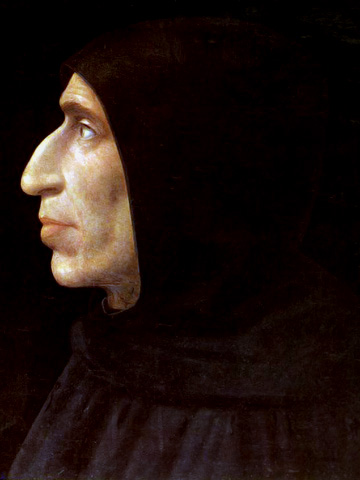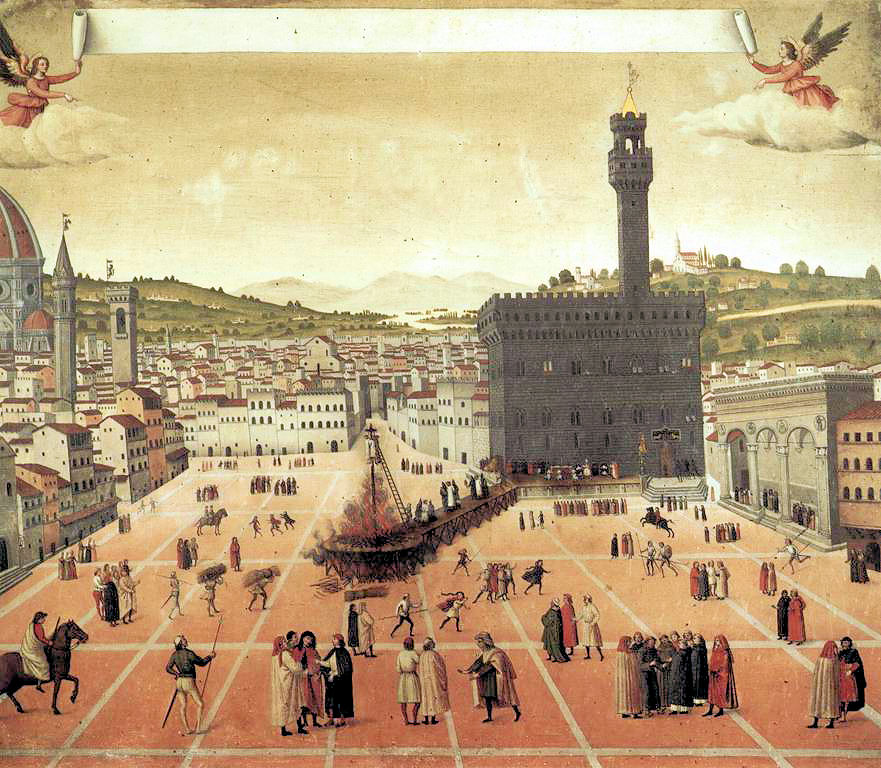
Girolamo Savonarola (1452-1498)
On February 7, 1497, Florentine followers of Dominican priest Girolamo Savonarola burned a bonfire of vanities. Supporters of Savonarola collected and publicly burned thousands of objects such as cosmetics, art, and books in Florence, Italy, on the Mardi Gras festival. Other targets included books that were deemed to be immoral, such as works by Boccaccio, and manuscripts of secular songs, as well as artworks, including paintings of Sandro Botticelli.
“The Pope may err, and that in two ways, either because he is erroneously informed, or from malice. As to the latter cause we leave that to the judgment of God, and believe rather that he has been misinformed. In our own case I can prove that he has been falsely persuaded. Therefore any one who obstinately upholds the excommunication and affirms that I ought not to preach these doctrines is fighting against the kingdom of Christ, and supporting the kingdom of Satan, and is himself a heretic, and deserves to be excluded from the Christian community.”
– Girolamo Savonarola, Sermon (18 February 1498)
Fra Girolamo Savonarola
Fra Girolamo Savonarola was a Dominican priest who was assigned to work in Florence in 1490, largely thanks to the request of Lorenzo de’ Medici – an irony, considering that within a few years Savonarola would become one of the foremost enemies of the Medici house and helped to bring about their downfall in 1494. Savonarola was born on September 21, 1452, in Ferrara. In 1475, he became a member the Order of Friars Preachers at the Convent of San Domenico in Bologna, where he took his vows of poverty, chastity, and obedience and after a year was ordained to the priesthood. He studied Scripture, logic, Aristotelian philosophy and Thomistic theology in the Dominican study, practiced preaching to his fellow friars and engaged in disputations. In 1482, instead of resuming his studies in Bologna, Savonarola was assigned as lector, in the Convent of San Marco in Florence.
The Medicis as Powerful Patrons
For the next several years Savonarola lived as an itinerant preacher with a message of repentance and reform in the cities and convents of north Italy. In 1490, he was reassigned to San Marco. It seems that this was due to the initiative of the humanist philosopher-prince, Giovanni Pico della Mirandola [1], who was impressed with his learning and piety. Pico was in trouble with the Church for some of his unorthodox philosophical ideas and was living under the protection of Lorenzo the Magnificent, the Medici de facto ruler of Florence. To have Savonarola beside him as a spiritual counselor, he persuaded Lorenzo that the friar would bring prestige to the convent of San Marco and its Medici patrons.
A Preacher of Universal Peace
Savonarola had more and more become a religious extremist and began to campaign against what he considered to be the artistic and social excesses of Renaissance Italy, preaching with great vigor against any sort of luxury. He declared a new era of “universal peace.” On January 13, 1495 he preached to a huge audience in the Cathedral, recalling that he had begun prophesying in Florence four years earlier, although the divine light had come to him “more than fifteen, maybe twenty years ago.” He now claimed that he had predicted the deaths of Lorenzo de’ Medici and of Pope Innocent VIII in 1492 and the coming of the sword to Italy — the invasion of King Charles of France. As he had foreseen, God had chosen Florence, “the navel of Italy”, as his favorite and he repeated: if the city continued to do penance and began the work of renewal it would have riches, glory and power. His power and influence grew so that with time he became the effective ruler of Florence, and even had soldiers for his protection following him around everywhere.
“God has Chosen Florence”
“Do you wish to be free? Then above all things, love God, love your neighbor, love one another, love the common weal; then you will have true liberty.”
– Girolamo Savonarola, as quoted in [15]
Buoyed by liberation and prophetic promise, the Florentines embraced Savonarola’s campaign to rid the city of “vice”. Starting in February of 1495, during the time that would normally have hosted the festival known as Carnival, Savonarola began to host his regular “Bonfire of the Vanities.” He collected various objects that he considered to be objectionable; irreplaceable manuscripts, ancient sculptures, antique and modern paintings, priceless tapestries, and many other valuable works of art, as well as mirrors, musical instruments, books of divination, astrology, and magic. He destroyed the works of Ovid, Sextus Propertius, Dante, as well as Boccaccio.[2,3] So great was his influence that he even managed to obtain the cooperation of major contemporary artists such as Sandro Botticelli and Lorenzo di Credi, who reluctantly consigned some of their own works to his bonfires. Anyone who tried to object found their hands being forced by teams of ardent Savonarola supporters.
The Bonfire of Vanities
The Auto da fe (bonfire) of vanities held at the annual Florence carnival of 1497, probably marks the height of his activities as agitator. Thirteen hundred children, marching from house to house, demanded and collected the luxuries of the world that all were piled on to a huge pyramid and set alight. Women and maidens crowned with olive branches danced around the burning pile in a state of spiritual ecstasy. They encouraged townspeople to throw in their jewelry, wigs, silken garments, hair combs and even fake teeth. For a time the splendor of art had been destroyed by Savonarola. Christian ideals again become omnipotent and left no room for imagination or flights of fancy. The figures of the Saints, Virgin Mary and Christ had to be painted in accordance with the strict cannons that had for centuries prevailed. Painters cringed in their studios afraid to pick up a brush lest they be tossed into a burning fire or hung for offending the harsh aesthetic rules of Savonarola and his fanatical henchmen. [2]

Painting of Savonarola’s execution in the Piazza della Signoria
The Triumph of the Cross, Excommunication, and Death
“Whoever excommunicates me, excommunicates God.”
– Girolamo Savonarola, as quoted in [14]
After a time the people of Florence had had enough of his lunacy and puritanical edicts. Also his activity did not go unnoticed by the higher church officials. Pope Alexander VI excommunicated Savonarola on May 13, 1497 and ordered the Florentines to throw him out of the city or face punishment by the Church. Following intense discussion by officials about his fate, Savonarola withdrew from public appearances in March 1498 and composed his most famous work, The Triumph of the Cross.[4] In May 1498 Savonarola was accused of sedition, uttering false prophesies and various religious transgressions. He was charged, jailed and horrifically tortured for several days but never recanted his words.[2] Savonarola was executed on May 23, 1498, hung on a cross and burned to death. Ironically, the papal authorities would take a leaf out of Savonarola’s book on censorship, because the day after his execution they gave word that anyone in possession of the Friar’s writings had four days to turn them over to a papal agent to be destroyed. Anyone who failed to do so faced excommunication.
Bruce Gore, 18. The Medici, Savonarola, and Renaissance Florence, [15]
References and Further Reading:
- [1] Pico della Mirandola and the 900 Theses, SciHi blog, February 24, 2014.
- [2] Dante Alighieri and the Divine Comedy, SciHi Blog, September 14, 2013.
- [3] Boccaccio and his Decameron, SciHi Blog, December 21, 2013.
- [4] Bonfires of Vanity – Origins and History of the Iniquitous Bonfire of the Vanities and the lasting consequences on Art History, at HistoryOfPainters
- [5] Bonfires of Vanity, at The History Chanel
- [6] February 7 1497 – The Largest Bonfire of the Vanities Occurs in Florence, Italy, at MapsOfTheWorld
- [7] Catholic Encyclopedia entry on Girolamo Savonarola
- [8] “Savonarola”. University of Oregon. Winter 2015.
- [9] Texts by or about Savonarola, at Wikisource
- [10] Girolamo Savonarola at Wikidata
- [11] R Josiah Hotchkiss Gilbert, Dictionary of Burning Words of Brilliant Writers (1895), p. 378
- [12] The Florentine Monk (1869) by Charles Spurgeon
- [13] Savonarola: his Contest with Paganism (1851) by Orestes Brownson
- [14] Philip Hughes, A History of the Church: The Revolt Against the Church: Aquinas to Luther, (1947, 1979, 1993), Vol. 3, p. 493
- [15] Bruce Gore, 18. The Medici, Savonarola, and Renaissance Florence, Bruce Gore @ youtube
- [16] Timeline of people executed by burning, via DBpedia and Wikidata





